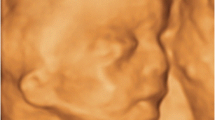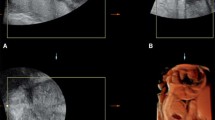Abstract
Background
Our objective is to present our experience of normal embryonic development and fetal anatomy and fetal anomalies reconstructed employing the three-dimensional (3D) and four-dimensional (4D) HDlive rendering mode.
Methods
A total of 18 normal embryos and fetuses and 21 abnormal fetuses (one case each of thoracic meningocele, thickened nuchal translucency, multicystic dysplastic kidney, gastroschisis, omphalocele, and ovarian cyst, five of hydrops fetalis, three of skeletal abnormality, three of chromosome abnormality, two of cystic hygroma, and two of amniotic band syndrome) at 7–36 weeks’ gestation were studied using the 3D/4D HDlive rendering mode.
Results
In normal fetuses, marked embryonic development with advancing gestation was clearly shown in the first trimester of pregnancy, and various realistic facial expressions were noted in the second and third trimesters. In abnormal fetuses, anatomically realistic features such as gross specimens were obtained. In particular, 3D/4D HDlive provides new, realistic sensations for the diagnosis of amniotic band syndrome, skeletal abnormalities, and facial abnormalities.
Conclusion
3D/4D HDlive rendering images seem to be more readily discernible than those obtained by conventional 3D/4D sonography. 3D/4D HDlive may be an important modality in future embryonic research, fetal neurobehavioral assessment, and the evaluation of fetal anomalies.










Similar content being viewed by others
References
Kurjak A, Pooh RK, Merce LT, Carrera JM, Salihagic-Kadic A, Andonotopo W (2005) Structural and functional early human development assessed by three-dimensional and four-dimensional sonography. Fertil Steril 84:1285–1299
Kurjak A, Azumendi G, Andonotopo W, Salihagic-Kadic A (2007) Three- and four-dimensional ultrasonography for the structural and functional evaluation of the fetal face. Am J Obstet Gynecol 196:16–28
Hata T, Dai SY, Marumo G (2010) Ultrasound for evaluation of fetal neurobehavioural development: from 2-D to 4-D ultrasound. Inf Child Dev 19:99–118
Hata T, Sato M, Kanenishi K, Hanaoka U, Tanaka H (2012) 4D sonography in assessment of fetal neurobehavior. Donald School J Ultrasound Obstet Gynecol 6:121–131
Kagan KO, Pintoffl K, Hoopmann M (2011) First-trimester ultrasound images using HDlive. Ultrasound Obstet Gynecol 38:607
Dulnuan DJ, Matsuoka M, Uketa E, Hayashi K, Murotsuki J, Nishimura G, Hata T (2011) Antenatal three-dimensional sonographic features of Roberts syndrome. Arch Gynecol Obstet 284:241–244
Hata T, Tanaka H, Noguchi J (2011) 3D/4D sonographic evaluation of amniotic band syndrome in early pregnancy: a supplement to 2D ultrasound. J Obstet Gynecol Res 37:656–660
Merz E, Abramovicz J, Baba K, Blaas HG, Deng J, Gindes L, Lee W, Platt L, Pretorius D, Schild R, Sladkevicius P, Timor-Tritsch I (2012) 3D imaging of the fetal face—recommendations from the International 3D Focus Group. Ultraschall Med 33:175–182
Hata T, Tenkumo C, Sato M, Kanenishi K, Ishimura M (2012) Three-dimensional HDlive rendered images of intrauterine abnormalities during pregnancy. J Med Ultrasonics (in press)
Zanforlin Filho SM, Araujo Júnior E, Guimarães Filho HA, Pires CR, Nardozza LMM, Moron AF (2007) Sonoembryology by three-dimensional ultrasonography: pictorial essay. Arch Gynecol Obstet 276:197–200
Conflict of interest
The authors declare no conflict of interest.
Author information
Authors and Affiliations
Corresponding author
Rights and permissions
About this article
Cite this article
Hata, T., Hanaoka, U., Tenkumo, C. et al. Three- and four-dimensional HDlive rendering images of normal and abnormal fetuses: pictorial essay. Arch Gynecol Obstet 286, 1431–1435 (2012). https://doi.org/10.1007/s00404-012-2505-1
Received:
Accepted:
Published:
Issue Date:
DOI: https://doi.org/10.1007/s00404-012-2505-1




